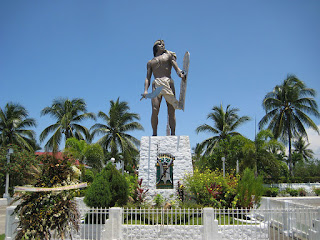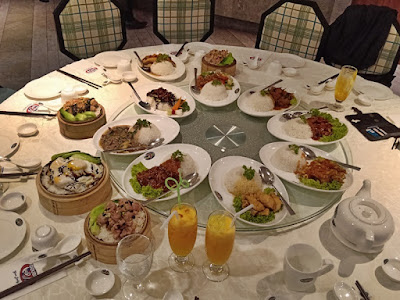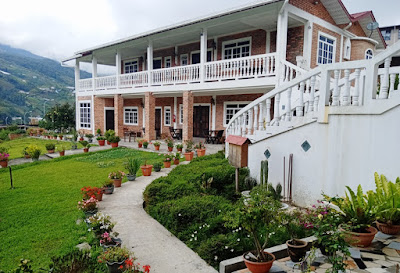A brief Sojourn in Cebu
 |
| Lapu Shrine in Cebu - By Rjruiziii/ commons.wikimedia.org |
A walk in Cebu
City, Philippines is just like home; we see people that are just like us in Sabah; and the
dialects spoken are very familiar, being that there are people who come from
this island, residing in Sabah. In fact, I can walk the street although I don't
talk the talk. Jokes, aside, it is a beautiful place to visit and my two weeks
there a few years ago was very enjoyable. I hope to go back there again one day
and enjoy the mango. Tons of them there, I can assure you..YUM!!
To share with
you: Cebu is the main centre of commerce, trade, education, and industry in the
central and southern islands of the Visayas. It has five-star hotels, casinos,
white sand beaches, world-class golf courses, convention centres, and various
shopping malls.
For sightseers
who wish to know the historical aspect of Cebu, the Casa Gorordo Museum is
probably one of the best sites to visit, besides the famous Basilica Minore del
Santo Niño.
The Casa Gorordo
Museum is well preserved and has been maintained carefully through the years.
The wood-and-stone house typical of Spanish era architecture in the Philippines
was once called home by four generations of the Gorordo family.
This house was
bought by the Ramon Aboitiz Foundation Inc in 1980 from the Gorordo family and
opened as a museum in 1983.
The foundation
hoped that the Casa Gorordo Museum will promote the conservation of cultural
heritage and enhance public appreciation of local history.
The preservation
of this house, its architectures and the artefacts contained within hoped to
perpetuate local history, instil understanding on Cebuano ethnicity and
inculcate consciousness on the need to preserve history.
Because of its
historical and social significance, the house was declared as a National
Landmark in 1991 by the National Historical Institute.
The preservation
of this house enable the public and tourists to savour heritage, history, and
culture through educational tours and other awareness-raising activities such
as history lecture series, art exhibits showcasing Cebuano artists and poetry
reading sessions.
After a walk
around Casa Gorordo, a visit to the Magellan's Cross is just proper. It is a
Christian cross planted by Portuguese and Spanish explorers as ordered by
Ferdinand Magellan upon arriving in Cebu in the Philippines on April 21, 1521.
This cross is
housed in a chapel next to the Basilica Minore del Santo Niño on Magallanes
Street, just in front of the city hall of Cebu City.
Tourists will
usually be informed that the original cross is encased within the present cross
found at the chapel’s centre.
This is to
protect the original cross from being chipped away by souvenir hunters or by
superstitious individuals who believed that the cross possesses miraculous
power. Soldiers have been known to chip away a piece of the cross and wear it
around their neck before going to battle.
Some people
however believe that the original cross is lost and has been replaced by the
Spaniards after they successfully colonized the Philippines. Magellan's Cross
is a symbol of Cebu, and the chapel's image can be found in its city seal. It
is also seen as the symbol of Roman Catholicism in the Philippines.
Move on and
visit the Port San Pedro or Fuerza de San Pedro. This is a military defence
structure, built by Spanish and indigenous Cebuano labourers under the command
of Spanish conquistador, Miguel López de Legazpi and the Spanish Government in
Cebu. It is located in the area now called Plaza Independence, in the Pier Area
of Cebu City.
Actually this
port can be akin to a large mansion and indeed it is believed to be the
smallest, oldest triangular bastion fort in the country.
It was built in
1738 to repel raiders and then served as a stronghold for Filipino
revolutionaries near the end of the 19th Century. It was the centre of the
first Spanish settlement in the Philippines.
The fort is
triangular in shape, with two sides facing the sea and the third side fronting
the land. The two sides facing the sea were defended with artillery and the
front with a strong palisade made of wood.
Fourteen cannons were mounted in their emplacements and most of them are
still there, a memento of a bygone era.
The date of
construction of the stone fort is uncertain, although there are claims that a
Jesuit Antonio Campioni built a stone fort in 1630, and the gate of fort bears
the date 1738 together with the arms of Castille and Leon.
According to
records, Fort San Pedro became a part of the American Warwick Barracks, a military
garrison established in 1899 by American military authorities. It was abandoned
in 1917 and from 1937 to 1941 the barracks was converted into a school where
many Cebuanos received their formal education.
During World War
II from 1942 to 1945, Japanese residents of the City took refuge within the
walls. When the battle for liberation was fought, the fort served as an
emergency hospital for the wounded.
From 1946 to
1950, Fort San Pedro was an army camp. After 1950, the Cebu Garden Club took
over and fixed the inner part and converted it into a miniature garden.
And today, it is
a National Shrine but still a garden, playing hosts to photographers and their
models, strolling singers with their guitars and curious visitors.
Visiting these
historical sites should be made compulsory for those who visit Cebu. For with
it we will get a glimpse of the people’s colourful history. In some ways, we
get to know the people too, through these visits.-AV



Comments
Post a Comment